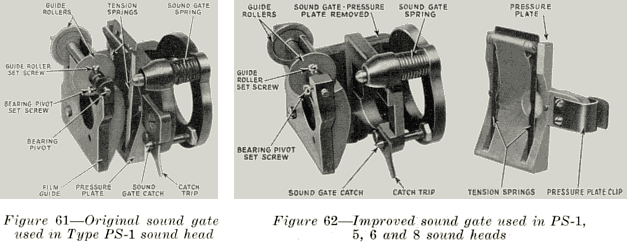The sound gate is very important and should be given constant attention. The
optical system has been adjusted to bring the light beam to an extremely sharp focus
at the point where the emulsion surface of the film is in contact with the film guide,
or gate shoe as it is usually called. If dirt or emulsion is permitted to collect on the
shoe, the film will be thrown out of its normal position; that is, brought out of the
proper focal plane, and the effect on the sound reproduction is the same as that
caused by throwing the optical system out of focus.
When the gate with the removable pressure plate is used take out the pressure
plate after every reel and clean the gate thoroughly. Be sure to use soft materials
only. Never use any metallic instrument such as a screw driver, knife blade, etc., as
a scratched gate shoe will scratch film and scratched film produces poor sound.
When replacing the pressure plate see that the lip of the plate starts into the recess
of the stationary part and press the plate on. The catch will automatically lock in
place and hold the pressure plate firmly. Care must be taken not to injure or bend
the tension spring.

The sound gate guide rollers must also be cleaned so that they will revolve
freely. If it becomes necessary to remove the roller assembly, do not disturb the
inside bearing pivot or loosen the collar which holds the outside roller in position. It
will then be very easy to return the guide roller assembly to its original position.
When replacing the guide roller assembly adjust the front bearing pivot so
there is no side play, while allowing the guide rollers to turn freely. This is important because the guide roller prevents the film from weaving, and holds it in such
a position that the light beam will not be in contact with any part of the film other
than the sound track. If the roller is replaced out of alignment, the beam may be
in contact with either the sprocket holes or the picture frame lines. The effect of
this will be a sound from the loud speakers like that of a motor-boat engine. The
stationary part of the sound gate contains a small rectangular light aperture which
allows the light from the optical system to reach the film. This light aperture should
be kept clean and free from lint at all times. If dirt collects in the aperture, the
amount of light reaching the film is reduced which results in low volume and "fuzzy"
reproduction.
5
